|
פירות ישראליים
pe-rot yis-ra-e-li-yim Israeli Fruits Israel grows more than forty types of fruits and exports most of it internationally. Israel has diverse climates that enable it to grow a wide range of crops. Most fruits grow in orchards located on the Mediterranean coast. Israelis eat fruits on a yearly average of 160 kilograms (350 lb) of fruit per person. Fruit is served as a snack, a drink of fresh-squeezed fruit, or as a desert of fruit salad or cooked fruits in juice known as a compote.
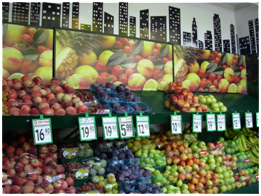 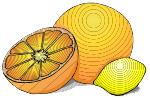 Citrus fruits are the third largest agricultural export with hundreds of thousands of tons of oranges, grapefruits, lemons, and pomelos exported yearly. Citrus fruits account for 7.1% of Israel's total agricultural produce. Grapefruits and especially the White Grapefruits are grown in inland valleys. Another popular grapefruit is the Sunrise variety that has a red peel and meat.
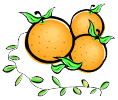 From the family of citrus fruits, pri hadar. Oranges and specially Shamouti oranges are Israel's major citrus product. Also knows as Jaffa oranges, they are seedless and sweet. First grown by Arab farmers in Palestine in the mid-19th century and was first produced for export in Jaffa. Jaffa oranges are harvested between November and March and more than half exported to the European Union. tapoozim (pl.), oranges.
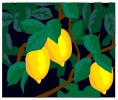 From the family of citrus fruits, pri hadar. Lemons are one of the main ingredient of an Israeli salad. It is used widely in Israeli cooking such as on fish. limonim (pl.), lemons.
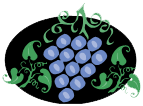 From the family of berry fruits, tootim. Grapes grow in the temperate climate of the mountains of the Galilee and the Golan. Vine leaves stuffed with meat and/or rice are a common appetizer. This appetizer goes back to the Ottoman Turks who introduced stuffed grape vine leaves in the sixteenth century.
Grape was one of the seven blessed species of fruit in ancient Israel and has a major religious importance. Israeli wine industry is moving from mostly producing Kosher wines to a worldwide international excellence of variety of wines. anavim (pl.), grapes.
 From the family of stone fleshy fruits, perot galeeniyim. Dates grow in the subtropical areas of Israel. They can grow in hot desert areas and can withstand long periods of drought. They can be eaten dry or soft, stuffed, or chopped in cereal, pudding, bread, or candy bars. Date was one of the seven blessed species of fruit in ancient Israel. Shavuot is the Festival of Reaping of the first fruits of the harvest (Bikurim). Kids parade with baskets full of Israeli fruits from the Seven Species: wheat, barley, grapes, figs, pomegranates, olives, and dates. tmarim (pl.), dates.
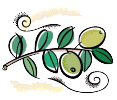 From the family of stone fleshy fruits, perot galeeniyim. Olives are one of the seven native ancient Israel fruits. The national emblem of the State of Israel includes a Menorah, flanked by two olive branches as a symbol of peace. Olives bloom in the spring and grow to be over 1,000 years old. Olive oil used to light the menorahs and food cooked in oil are traditions of Chanukkah in memory of the oil that was used in the Temple at the time of its rededication. 89% of Israelis use olive oil for cooking and seasoning of the famous Israeli salad. zeytim (pl.), olives.
 From the family of pome fleshy fruits, perot hartzaniyim. Apples grow in the temperate climate of the mountains of the Galilee and the Golan which is in the Northern area of Israel. tapoohim (pl.), apples.
 From the family of tropical fruits, perot tropiyim. Prickly Pear, Tzabar, is the symbol of new Israeli because it is prickly from the outside and sweet from the inside. It grows wild in Israel and is eaten after refrigerating on hot summer days. tzabarim (pl.), prickly pears.
 From the family of dry fruits/nuts, perot yeveshim - pitzoohim. Pitzoohim are roasted nuts and seeds. Israelis love to eat pitzoohim on outings and at home. The Pistachio is very popular among the pitzoohim. They are usually purchased at markets and are roasted, semi-opened, salted and easy to eat. fistookim (pl.), pistachio nuts.
 From the family of tropical fruits, perot tropiyim. Bananas grow in the subtropical areas of Israel near the Sea of Galilee and in the Jordan River Valley. bananot (pl.), bananas.
 From the family of tropical fruits, perot tropiyim. Pomegranates are native to the Middle-East and are rich in anti-oxidants. The pomegranate fruit is a symbol of fertility in the Bible and is one of the seven species of Israel. Each fruit is said to contain 613 seeds just as there are 613 good deeds, mitzvot. Pomegranate is eaten on the Jewish New Year, Rosh Hashana, to wish for good deeds and plentiful year as the seeds of the pomegranate. rimonim (pl.), pomegranates.
 From the family of tropical fruits, perot tropiyim. Kiwis grow in the subtropical areas of Israel near the Sea of Galilee and in the Jordan River Valley. kivi (pl.), kiwis.
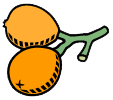 From the family of pome fleshy fruits, perot hartzaniyim. Loquats, shesek, are one of the leading exports of Israel. shesakim (pl.), Japan plums.
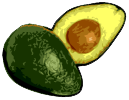 From the family of tropical fruits, perot tropiyim. Avocados are eaten as a salad or a dip in the winter. They were introduced on the coastal plain in the 1920s. avokadoeem (pl.), avocados.
|